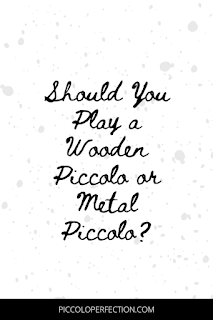Plastic vs. Wood Piccolo: Which Is Better?
Do the different piccolo materials overwhelm you? You're not alone; the difference between a plastic and wood piccolo can seem small, but you may want one material over the other.
Last week, I compared metal and wood piccolos. So this week, I decided to compare the wood piccolo to the plastic piccolo.
But first, this post contains affiliate links. Click here to read the full disclosure policy.
Why Play a Plastic Piccolo
Playing a plastic piccolo can be an excellent option for beginners, professionals, and everyone in between. You don't need to have a ton of playing experience to get a good sound.
But if you aren't convinced, consider a few benefits of plastic piccolos.
Affordable
Whether you're a beginner or only play piccolo occasionally, you may not be able to justify spending thousands of dollars on an instrument. However, most plastic piccolos cost around $1,000 or even less.
That means you can get a fantastic instrument that meets your needs without breaking the bank. And if you end up not playing the piccolo as much as you thought, you won't be out as much money.
Plastic piccolos are great for students and anyone else on a budget. While you can save up for a wood piccolo, that can take a lot of time, and you may need or want an instrument sooner.
Low-Maintenance
Compared to wood, plastic doesn't require as much maintenance and care. Of course, you need to make sure you don't drop your piccolo and that you swab it out after you practice.
However, you don't have to worry about keeping the instrument from cracking. If you need to take a break from the piccolo or if you decide to upgrade, it can stay in good condition in storage.
That makes it an amazing choice for woodwind doublers and other casual players. If you don't have the time to play the piccolo every day, you don't have to worry about the piccolo.
Durable
Plastic is also great for students and players who care about durability. Not only do you not have to worry about cracking, but you can play it almost anywhere.
That makes it great for an indoor orchestra but also for marching band. And you don't have to take the best care of the instrument to keep them in playing condition.
So new players and students can learn how to take care of a piccolo. But they don't have as much of a risk of damaging it beyond repair.
Good Sound
Another fantastic benefit of playing a plastic piccolo is that you can get a good sound. They may not sound as warm as wood, but they can sound warmer than metal.
As a beginner, you want to get a good sound so that you like playing and want to continue. Plus, you won't have to worry about annoying others in your home when you practice.
Even as you get better at the piccolo, your sound can improve as well. So you don't have to rush to upgrade to a better model if you can't afford it.
Nice Appearance
Like it or not, flute players can be pretty vain. It can be easy to judge other musicians based on how their instruments look, and that's especially true with the piccolo.
Most plastic piccolos look very similar to wood ones, more so from afar. Odds are, people won't know you play a plastic model unless you specifically tell them.
The appearance also can help you fit in with a piccolo section in a marching band. If the other players use plastic models, you may need a similar one.
Best Plastic Piccolos
If you're ready to get started with a plastic piccolo, you need to know about the best models. Sadly, some piccolos aren't as good as others, and they can keep you from making progress.
However, I do know of a few amazing plastic models that are all pretty affordable. Even though I haven't played them, they are all from reputable brands, and other musicians do play and love them.
So consider the following models to help you find the best plastic piccolo for you.
Jupiter JPC1010
The Jupiter JPC1010 is an amazing entry-level plastic piccolo. It has both a plastic headjoint and a plastic body, and the keys are silver-plated.
Jupiter is one of the most well-known brands for student instruments. Whether you're a beginner or need a good backup piccolo, you can't go wrong with this model.
It looks very similar to a wood piccolo, and it doesn't have a cork. That's really nice because you don't have to worry about the cork breaking down if you let it dry out.
Gemeinhardt 4P
Another great plastic model to try is the Gemeinhardt 4P. This piccolo shares the same appearance as wood, and it has silver-plated keys.
If you've played a Gemeinhardt flute, you will probably enjoy this piccolo. You can get a good sound on it, and it's more affordable than other plastic models.
Like other plastic instruments, you may not get the warmest tone. However, the 4P is a great first piccolo for students, amateurs, and aspiring professionals.
Yamaha YPC-32
A slightly different plastic piccolo, the Yamaha YPC-32 features a plastic body and a metal headjoint. That design is pretty common among piccolos.
The metal headjoint offers a lip plate, which can help you switch between flute and piccolo. And the plastic body keeps your sound from getting to shrill.
You'll find a lot of students play this type of piccolo in band or orchestra. With Yamaha's reputation for making good instruments, this is a great option to try.
Why Play a Wood Piccolo
While plastic piccolos are great, they do have some limitations. If you get really serious about music, you may want to upgrade to a wood piccolo.
There are a few benefits that come from such an upgrade. Even if you don't pursue a career in music, you should know why wood is worth it.
Warm Sound
The wood piccolo offers a very warm sound, which is hard to get from the high range that the piccolo can play. So if you struggle with getting a warm tone, the wood may help.
Of course, you still need to put in the work to figure out how your wood piccolo wants to be played. And you may struggle for a while to get the sound you want.
But over time, you may find that getting the sound you desire gets easier. Plus, the wood sound allows you to blend very well with others in an ensemble.
More Specs
Most professional piccolos are wood models. Because of that level, you have access to more specs and customizations than with plastic piccolos.
For one, you can choose between different headjoint cuts that work with you. And you can also get keys like the split E mechanism, high G# facilitator, and the Brossa F#.
Some plastic piccolos have the split E mechanism, but that's the most I've seen in terms of different specs. You may also find a couple of headjoint cuts, but the options are slimmer.
Different Woods
Plus, wood piccolos come in different woods, which can help you customize your instrument even more. Then, you can choose a model that you love and that will let you be the best musician you can be.
If you don't like the sound of grenadilla, there are plenty of other woods to check out. You can get cocus wood and rosewood piccolos, but those do cost more.
Another option is to get a different headjoint. These come in even more woods, and you can look at headjoint makers, such as Hernandez and Mancke.
Professional
I mentioned this already, but flute players can be vain. If you want to become a professional musician, you may face some judgment for not having a wood piccolo.
When you can afford to upgrade, it can change how others perceive you. But it can also change how you perceive yourself.
I know I felt a bit of imposter syndrome before I got my wood piccolo. While I still need to practice, having the "better" piccolo does give some comfort, you could say.
Best Wood Piccolos
If you're ready to upgrade from a plastic piccolo or another model, you should choose a good wood piccolo. That way, you can make sure the investment is worth it, and you can avoid buyer's remorse.
Of course, you should take the time to try as many wood piccolos as you can. What works for me and what I'd recommend may not work well for you. Still, here are a few models to try.
Trevor James Blaze
Trevor James is one of the most well-known flute brands, and they make fantastic C flutes and low flutes. They aren't as well-known for their piccolos, but they do make them.
The Trevor James Blaze piccolo is pretty affordable, and it's even cheaper than some metal and composite models. If you want to get a good deal, you should check out this instrument.
I've seen quite a few people talk about it and try it, and most seem to like it. Now, it doesn't have a ton of additional specs, but it can get the job done.
Yamaha YPC-62
The Yamaha YPC-62 is another great wood piccolo. It's not as cheap as the Blaze, but it's still cheaper than a lot of other wood piccolos.
I believe this was the model I played on when I was in college. At the time, I only had my metal piccolo, so I borrowed a school-owned instrument for indoor concerts.
This piccolo is great for doublers or flute players who don't play the piccolo often. But if you want to get really serious about the piccolo, you may find this model limits you.
Hammig 650/3
Now for my personal wood piccolo, the Hammig 650/3. This model uses grenadilla wood, and it has a split E mechanism and a high G# facilitator.
You can choose between three different headjoint cuts, including the traditional, wave, and modern wave cuts. I chose the wave cut, which is great for anyone who plays with a lot of air.
Hammig piccolos are great, and if you don't like the 650/3, you can try the other models. And you can easily get a headjoint from a different maker if you prefer.
What About Composite Piccolos?
If you want to enjoy the benefits of both a plastic and a wood piccolo, check out composite models. The material is a combination of wood and plastic.
Plastic helps stabilize the wood to prevent cracking, while wood helps make the instrument sound warm. Plus, composite piccolos tend to cost less than wood models.
I have the Pearl 105 as my backup piccolo, and I played it as my main piccolo for years. It's a great choice for a backup but also for casual players.
Will You Get a Plastic or Wood Piccolo?
If you're ready to start playing the piccolo or upgrade your instrument, you should decide between a plastic and wood piccolo. Both offer unique pros and cons, and one is not better than the other.
You have to consider how much time you have to practice and play the instrument. But you may also need to prioritize your finances.
Either way, try as many piccolos as you can. That way, you'll be able to select an instrument that will help you make progress and enjoy playing.



Comments
Post a Comment